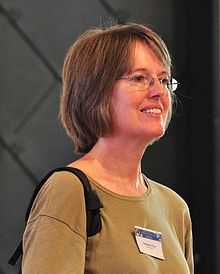Stephanie Peay
| Stephanie Peay | |
|---|---|
|
Stephanie Peay at Pisek crayfish conference. | |
| Born | 1959 |
| Nationality | British |
| Occupation | Ecologist - Researcher |
Stephanie Peay (born 1959) is a British ecologist and crayfish researcher.
Life and work
Peay is an alumna of Edinburgh University and Hull University and in 2014 was awarded a PhD by Leeds University . She is a Member of the Institute of Ecology and Environmental Management and a Chartered Environmentalist.
In her early professional career, in 1984, she compiled the first draft of the ancient woodland inventory for West Sussex.[1]
After working for the Farming and Wildlife Advisory Group she worked for Cobham Resource Consultants, later part of the Scott Wilson Group, as an ecological consultant, where her interests in the white clawed crayfish, Austropotamobius pallipes and signal crayfish, Pacifastacus leniusculus began.
As an independent crayfish researcher her research has concentrated on the protection of the UK native white clawed crayfish and restricting the invasion of the alien signal crayfish.
Peay is a leading proponent of crayfish conservation and management in Britain [2] and has produced much of the guidance on crayfish used by British ecologists and managers on survey and monitoring methods,[3][4] restoration of habitat,[5] mitigation during works on waterbodies,[6] and, latterly, on “ark sites" to safeguard white-clawed crayfish.[7] She also provides advice and training for organisations such as the Wildlife Trusts, Environment Agency,[5] Scottish Natural Heritage,[8] BBC[9][10] and others.
As invading signal crayfish are a major threat to native crayfish, both in Britain and in Europe,[11] Peay has studied the effects of signal crayfish on white clawed crayfish and their environment, particularly on native fish stocks,[12] and has researched control and eradication methods.[8]
She represents the Wildlife Trusts on the UK Biodiversity Action Plan Steering Group for white clawed crayfish, is a board member of the International Association of Astacology and has contributed to the European CRAYNET programme.[13]
In her employment as Technical Director, Ecology with URS Corporation, Peay has considerable experience of ecological surveys, ecological assessment and management in a range of habitats in the UK on many types of projects, notably in water resources development roads and airports.
She is also a visiting lecturer at Leeds University.[14]
References
- ↑ Whitbread A, Barton J and Hutton D, WEST SUSSEX INVENTORY OF ANCIENT WOODLAND, Nature Conservancy Council CRDA/43/dd/2/46
- ↑ Perkin, Scott (2010), Norfolk Biodiversity partnership progress report (PDF), p. 8
- ↑ Stephanie Peay (2003). Monitoring the White-clawed crayfish (Austropotamobius pallipes) (PDF). English Nature. ISBN 1-85716-727-9.
- ↑ S.Peay (2004), A cost-led evaluation of survey methods and monitoring for White-clawed crayfish, Bull. Fr. Pêche Piscic., pp. 335–352
- ↑ 5.0 5.1 Peay S. (2002), Guidance on Habitat for White-clawed crayfish and its restoration., Environment Agency Technical Report W1-067/T
- ↑ Peay S (1999), Guidance on works affecting white-clawed crayfish (PDF), English Nature
- ↑ Peay, S. Whitehouse, A. & Kindemba, V. (2009). Ark sites for White-clawed crayfish – guidance for the aggregates industry (PDF). Buglife. ISBN 978-1-904878-95-7.
- ↑ 8.0 8.1 Peay S. et al. (2006), Biocide treatment of ponds in Scotland to eradicate signal crayfish. (PDF), Scottish Natural Heritage
- ↑ James Lynn (11 July 2006). "Plight of the white-clawed crayfish". BBC News.
- ↑ Morelle, Rebecca (15 October 2008). "Aquatic alien 'thugs' set to meet". BBC News. Retrieved 6 May 2010.
- ↑ Catherine Souty-Grosset C et al. (2006). Atlas of Crayfish in Europe. Museum national d’Histoire naturelle. pp. 25–47.
- ↑ Peay S. et al. (2009), The impact of signal crayfish (Pacifastacus leniusculus) on the recruitment of salmonid fish in a headwater stream in Yorkshire, England., Knowledge and Management of Aquatic Ecosystems, pp. 394–395., doi:10.1051/kmae/2010003
- ↑ Catherine Souty-Grosset C et al. (2006). Atlas of Crayfish in Europe. Museum national d’Histoire naturelle. pp. 152–157.
- ↑ "Staff profile - Stephanie Peay". University of Leeds Faculty of Biological Science. Retrieved 6 May 2010.
|
